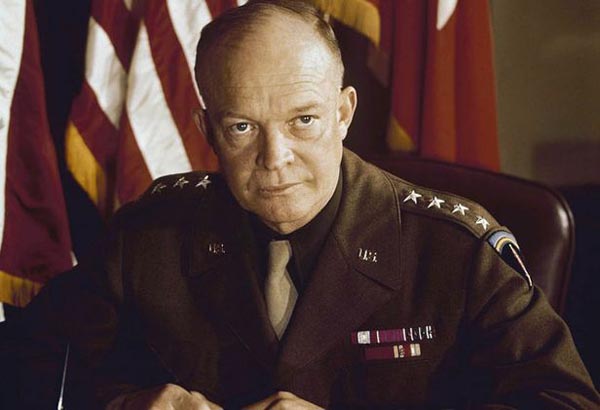Ike was right all along: The danger of the military-industrial complex
Source: independent.co.uk

Fifty years ago, President Eisenhower warned of the danger of the ’military-industrial complex’. The huge budget and reach of America’s modern defence industry has proved him correct, says Rupert Cornwell
If you doubt, half a century on, that Dwight Eisenhower had it right, then consider the advertisements on WTOP, the Washington region’s all-news radio station. Every big metro area in the US has one, where car dealerships tout their bargains, and fast food chains promote a new special offer.
WTOP has all that. But it boasts other advertisers too, with names such as Boeing, Lockheed Martin and General Dynamics.
Of course, the average listener can’t remotely afford a brand new military aircraft, or a state-of-the-art battlefield management system. But that’s not the point. These almost otherworldly ads, with patriotic music playing softly in the background, are aimed at a very restricted audience: the government that is their only customer for such wares. For the rest of us, they are proof that in the capital of the world’s richest democracy, the defence industry is a very big player indeed.
Eisenhower warns us of the military industrial complex.
Video from: YouTube.com
Exactly 50 years ago, on January 17 1961, Eisenhower delivered one of the most celebrated farewell speeches in American history, whose fame has only increased over the decades, eclipsed not even by JFK’s inspirational inaugural that followed three days later. Kennedy might have projected the dynamism of youth. But the old soldier won the prize for prescience.
In his speech, Eisenhower warned about the growth of a ’military-industrial complex,’ and the risks it could pose. "The potential for the disastrous rise of misplaced power," Ike said, "exists and will persist." His anxieties back then were prompted by the ten-fold expansion of the US military after two world wars, and by the development of a "permanent arms industry of vast proportions". Today, the proportions of both the military and the industry that serves it are vaster than ever.
Adjusted for inflation, US national security spending has more than doubled since Eisenhower left office. Year after year, the defence budget seems to rise – irrespective of whether the country is actually fighting major wars, regardless of the fact that the Soviet Union, the country’s former global adversary, has ceased to be, and no matter which party controls the White House and Congress.
One common thread however exists: the military-industrial complex, or perhaps (as Eisenhower himself described it in a draft of his speech that was later amended) the military-industrial-congressional complex. Others have referred to the beast as the "Iron Triangle".
In one corner of the triangle stands the arms industry. The second is constituted by the government, or more precisely the Pentagon, the end-consumer of the industry’s output. In a totalitarian state, such as the Soviet Union, that combination would be sufficient. The US however is a democracy, and a third corner is required – an elected legislature to vote funds to pay for the arms. This is Congress, made up of members who rely on the defence industry for many jobs in their states and districts, and for money to help finance their every more expensive re-election campaigns.
But maybe even triangle is an inadequate description. Today, more than ever, a fourth element underpins the military-industrial complex. It is the extraordinary prestige, verging on veneration, Americans accord their armed forces. Whatever the country’s soldiers need, the general public broadly believes, they should have.
In fact, the MIC is not the largest show in town. According to the specialist website of the same name that tracks US defence spending, the total value of contracts issued by the Pentagon since October 2006 exceeds $1.1 trillion, while total military spending in that period tops $2.5 trillion. But even these gigantic sums pale beside a health-care sector now accounting for a sixth of the entire national economy.
The difference of course is that the MIC basks in the reflected glory of the military, shown by poll after poll to be the most trusted institution in the land. In terms of trust and admiration, the health insurance and drug companies rank right down there with Wall Street and the banks.
Nonetheless Eisenhower’s warning has never ceased to resonate since his death in 1969. Indeed, it is one reason that in the stock market of posthumous presidential reputations, few have risen like his.
When he delivered that farewell address, America couldn’t wait to be rid of him. Ike was regarded as senile and semi-detached, utterly out of touch with the times. The future lay with Kennedy, symbol of vigour, youth and novelty. But the old general knew whereof he spoke. Indeed, the MIC had worried him for years.
A treasure trove of old documents, covered with dirt and pine needles and discovered last year at a cabin in Minnesota once owned by Eisenhower’s chief speechwriter Malcolm Moos, reveals that the 34th president had been working on the speech since mid-1959. It went through at least 21 drafts; in a later one, the "congressional" reference was struck out because, it is supposed, Ike did not want to upset old friends on Capitol Hill. But the "military" part was there from the outset.
At the time, the speech raised few eyebrows. Now its words are viewed as prophetic, and the man who spoke them is deemed one of America’s greater presidents. From today’s anxious vantage point, the 1950s are remembered as a golden age of order, contentment and certainty. Ike himself is perceived as a wise and measured statesman who most certainly would never have led the US into the ruinous Iraq adventure.
In fact, for all his strictures about the MIC, the worst has not come to pass. Wars have always been good business for weapons manufacturers – and so it has been with Korea, Vietnam, Afghanistan and Iraq. The arms industry therefore was never going to be very happy with the notion of a "peace dividend" at the end of the Cold War.
But it is a leap to describe modern America as a "warfare state" – in which the Iraq war, say, was the direct result of a colossal conspiracy by the arms industry to force the country into a conflict purely to enrich itself. As for the ultimate nightmare, a military take-over akin to the one that came close to in John Frankenheimer’s fictional 1964 political thriller Seven Days in May, that is simply inconceivable.
The true tragedy is not quite the one that Eisenhower imagined. The US by itself accounts for roughly half of military spending worldwide. How much better if some of that money would be used to improve the country’s education and infrastructure, or provide health care for all, or increase foreign aid, rather than on protecting America from threats that geography alone renders illusory.
In reality, the dangers of Eisenhower’s "military-industrial complex" are not new; from the earliest days of the Republic, political leaders have warned of them. "Overgrown military establishments," George Washington said in his own farewell address of 1796, "are under any form of government inauspicious to liberty." Nor is the concept confined to America.
In the Soviet Union, the ultra-secret arms industry devoured a third or more of GDP (compared to around 4 per cent in the US currently) and was a cornerstone of Communist power. Or, closer to home, consider Krupp in Germany during two world wars, or later Dassault in France, or Vickers and British Aerospace in the UK. But nowhere has the synergy between government and defence manufacturers, most of them headquartered a lobbyist’s lunch drive from the Capitol, been as entrenched as in the US.
Ah yes, some say, but the tide is now starting to turn. After experiencing some contraction in the 1990s, the industry enjoyed a boom after 9/11. But the deep recession of 2008-2009 and the continuing colossal deficits will not spare even the hitherto sacrosanct Pentagon budget.
Once again, one might note, Eisenhower hit the mark in January 1961. Back then, budgets were more or less balanced, and the possibilities of the future seemingly boundless. Even so he urged his countrymen to "avoid the impulse to live only for today, plundering for our own ease and convenience the precious resources of tomorrow". That of course is what has happened with the "credit card" wars of Iraq and Afghanistan, whose costs will burden American taxpayers for years to come.
Nor is that reality lost on Robert Gates, the Defence Secretary, who back in May was warning that Congress could not, and would not, write blank cheques for ever. The Pentagon had to make every dollar count, he said, rather than indulge in such projects as "$20m howitzers, $2bn bombers, and $6bn destroyers." Alas, as Gates knows full well, the arms contract that comes on budget has yet to be invented.
Since then of course Republicans have taken back the House of Representatives, which controls the pursestrings of government, a victory driven by a Tea Party movement vowing to eradicate deficits. Last week, Gates announced $78bn of cuts over the next five years, to pre-empt demands from deficit hawks for even greater reductions. But the MIC has survived far worse, and will most certainly survive this modest downturn in its fortunes.
For one thing, even when the Pentagon wants to cut a programme, Congress – prodded by its defence contractor benefactors – sometimes won’t let it. Take the case of the back-up second engine for the F-35 Joint Strike Fighter, the most expensive procurement programme in even the Pentagon’s extravagant history, at a total of $382bn or a mere $112m per aircraft. The Pentagon doesn’t want the second engine, to be built by GE and Rolls-Royce, and nor does the White House. But it gets funded anyway.
And so the show goes on. The Republicans may vote through some shrinking of the military budget. But giant arms projects, however wasteful, provide jobs and exports at a time when the broader economy struggles to do either. Congress will not sacrifice them lightly.
At the same time, the infamous "revolving door" between the Defense Department, the top military contractors, their lobbyists and congressional staffers will continue to spin, strengthening a commonality of viewpoint between the separate components of the MIC, and tightening the bonds of the "Iron Triangle".
Campaign contributions meanwhile will grow even more important. Defence companies give money to sitting Congressmen who have fought their corner. True, in the ferociously anti-incumbent mid-terms of last November, they could not save Ike Skelton, their ally and chairman of the House Armed Services Committee, from defeat.
But financial support from Boeing workers was key in the re-election of Senator Patty Murray from Washington State, where she has fought hard to save Boeing jobs threatened if the company loses its bid for a $35bn tanker contract, for which the European-based EADS is also competing. That battle, incidentally, is also playing out in its own fierce ad war on WTOP, aimed at the same audience of government and Congress.
And even if budgetary pressures temporarily compress the market for top-of-the-line military hardware, fear not. The demand for national security and intelligence in the "war on terror" continues to surge – to the point that a Washington Post investigation last summer found that 33 facilities for intelligence work, equal to three new Pentagons, have gone up around Washington alone since 9/11.
Most fundamentally, there remains the popularity of all things military, at a time when civilian leaders with the stature and experience to challenge the Pentagon brass, and by extension the MIC, are few. George HW Bush was the last commander-in-chief to have tasted war and its horrors. His son famously had not, and – perhaps to make up for it – gave the military everything it wanted, and more. So maybe there is only one answer. America should elect a general as commander-in-chief. Like Dwight D. Eisenhower.
Article from: independent.co.uk






















